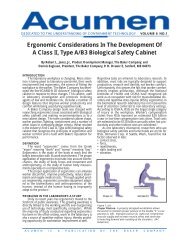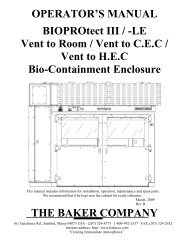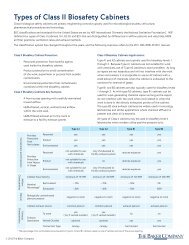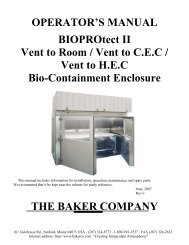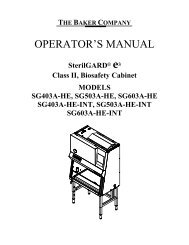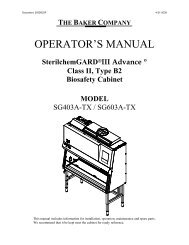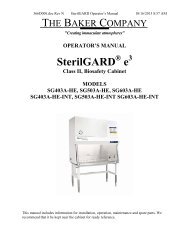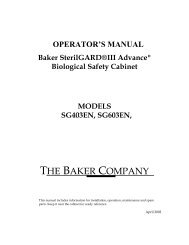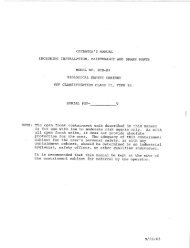Download the BioChemGARD white paper - The Baker Company Blog
Download the BioChemGARD white paper - The Baker Company Blog
Download the BioChemGARD white paper - The Baker Company Blog
You also want an ePaper? Increase the reach of your titles
YUMPU automatically turns print PDFs into web optimized ePapers that Google loves.
Decreased Static Pressure of Building Exhaust System<br />
<strong>The</strong> building exhaust system needs to provide sufficient<br />
exhaust airflow and static pressure to meet <strong>the</strong><br />
Concurrent Balance Values (CBVs) of a total exhaust<br />
BSC. CBVs help ensure that sufficient airflow and<br />
static pressure is designed into <strong>the</strong> building exhaust<br />
system; <strong>the</strong>se values are factored into <strong>the</strong> performance<br />
requirements of <strong>the</strong> building exhaust system.<br />
When tested in <strong>the</strong> <strong>Baker</strong> Laboratory, <strong>the</strong> <strong>BioChemGARD</strong><br />
e3 showed a 20% reduction in <strong>the</strong> resistance or static<br />
pressure requirements for a facility to exhaust <strong>the</strong> air<br />
when compared to <strong>the</strong> SterilChemGARD cabinet. <strong>The</strong><br />
measured static pressure values and CBVs are shown<br />
below (Table 3).<br />
Exhaust Flow Rate (Total<br />
CFM)<br />
Exhaust Negative Static<br />
Pressure (W.G.) – Measured<br />
Exhaust Negative Static<br />
Pressure (W.G.) – Concurrent<br />
Balance Values<br />
Traditional<br />
B2 BSC<br />
BCG e3<br />
802 664<br />
1.0 0.8<br />
1.7 1.5<br />
Table 3: Exhaust Negative Static Pressure and CBVs of 4-foot nominal<br />
model with 12-inch collar.<br />
<strong>The</strong>se values can be used to calculate <strong>the</strong> amount of<br />
energy needed to meet <strong>the</strong> CBV and static pressure<br />
requirements for any given facility. <strong>The</strong> Fan Affinity<br />
Laws in <strong>The</strong> Industrial Ventilation Manual show how to<br />
calculate <strong>the</strong> power required for a facility to exhaust a<br />
BSC. 7 This formula was applied to our <strong>BioChemGARD</strong> e3<br />
and o<strong>the</strong>r Type B2 cabinets to compare static pressure<br />
Heat<br />
Generation<br />
(BTU / Hr )<br />
Exhaust Flow<br />
Rate<br />
(Total CFM)<br />
Exhaust<br />
Negative<br />
Static Pressure<br />
(W.G.)<br />
Traditional<br />
B2 BSC<br />
BCG<br />
e3<br />
BCG e3,<br />
ReadySAFE<br />
BCG e3,<br />
Optimal<br />
955 392 119 212<br />
802 664 300 421<br />
1.7 1.5 1.5 1.5<br />
Horsepower 0.29 0.208 0.09 0.13<br />
kWh 0.21 0.16 0.07 0.10<br />
kWh / 24 5.12 3.74 1.69 2.37<br />
Table 4: Static Pressure Power Requirements<br />
requirements (Table 4). Please note, typical fan<br />
efficiency is 65% to 85%, so an average of 75% was used<br />
in <strong>the</strong> below calculations.<br />
Based on <strong>the</strong> performance data listed above, when<br />
<strong>the</strong> cabinet is running in optimal conditions for 24<br />
hours, a facility may realize a reduction up to 55% in<br />
<strong>the</strong> horsepower required to exhaust <strong>the</strong> BSC when<br />
compared to o<strong>the</strong>r B2 cabinets.<br />
Results for a specific facility are largely dependent<br />
upon <strong>the</strong> size of <strong>the</strong> fan and <strong>the</strong> configuration and<br />
construction details of its exhaust system. In <strong>the</strong> <strong>Baker</strong><br />
laboratory, a SterilChemGARD and a <strong>BioChemGARD</strong> e3<br />
were attached to an exhaust system measuring 25 feet<br />
to more closely simulate a real-life application of this<br />
analysis (Table 5).<br />
Fan efficiency was measured at 75%, fur<strong>the</strong>r validating<br />
<strong>the</strong> calculations performed above and shown in table 5.<br />
<strong>The</strong>se tests corroborate <strong>the</strong> impact that reductions in<br />
volume (CFM) and static pressure (inches, W.C.) have<br />
on <strong>the</strong> exhaust power requirements for a laboratory.<br />
<strong>The</strong> <strong>BioChemGARD</strong> e3 can help facilities and laboratories<br />
achieve significant energy savings, not only from<br />
normal cabinet operation but also from <strong>the</strong> reduction in<br />
<strong>the</strong> conditioned air and static pressure requirements for<br />
<strong>the</strong> laboratory and <strong>the</strong> facility.<br />
Exhaust Flow Rate (Total<br />
CFM)<br />
Exhaust Negative Static<br />
Pressure (W.G.)<br />
SterilChem-<br />
GARD<br />
BCG e3<br />
860 664<br />
1.7 1.5<br />
Horsepower .45 .208<br />
kWh / 24 hr 8.08 3.74<br />
Table 5: Static Pressure Study<br />
Sustainable Design Reduces Total Cost of<br />
Ownership<br />
As a result of <strong>the</strong> efficiencies gained from <strong>the</strong><br />
sustainable design concepts and reduced airflow<br />
described above, <strong>the</strong> <strong>BioChemGARD</strong> e3 total exhaust<br />
cabinet will reduce <strong>the</strong> total amount of energy<br />
consumed within a laboratory, <strong>the</strong>reby creating<br />
significant operational cost savings for <strong>the</strong> facility<br />
(Table 6).<br />
Operating at only 664 CFM, electrical power<br />
requirements for a nominal 4-foot cabinet are 70% less<br />
• 5



